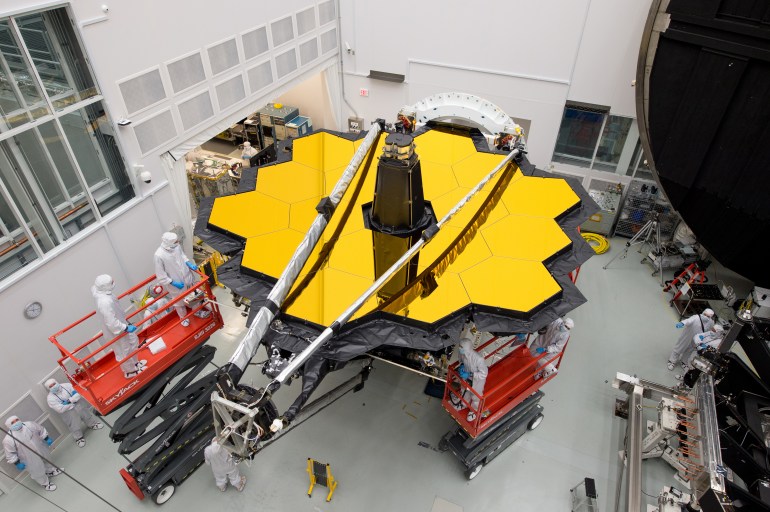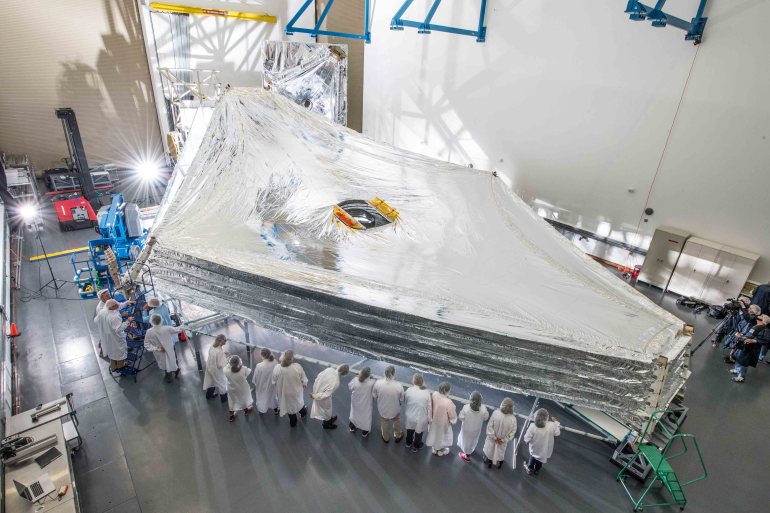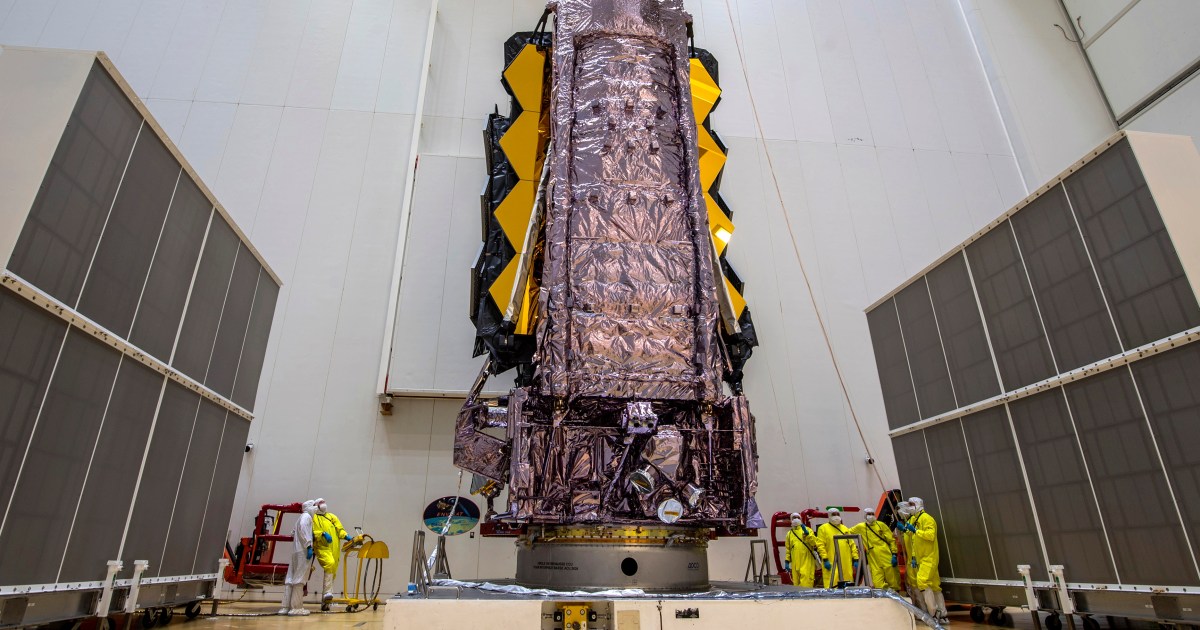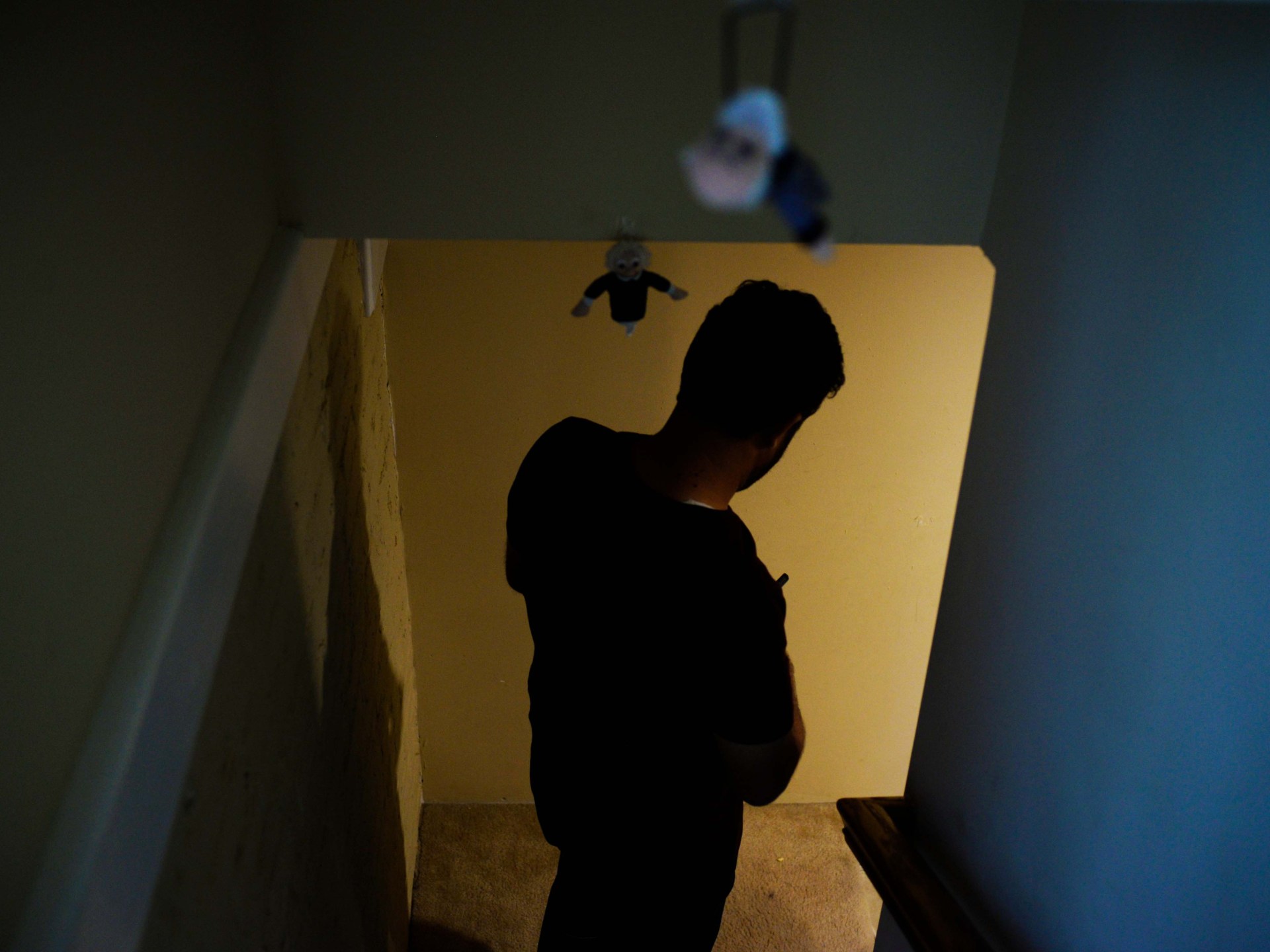James Webb Space Telescope nears long-awaited launch day | Space News
Astronomers and scientists may just be bestowed with an out-of-this-world gift this year. While children track Santa’s sleigh as it journeys around the Earth, something else is set to light up the sky as early as Christmas Eve: the long-awaited launch of the James Webb Space Telescope (JWST).
After nearly two decades of development, and around seven launch delays, the space observatory is now fully fuelled and sitting in the final assembly building in Kourou, French Guiana, ahead of blastoff scheduled for no earlier than December 24.
First conceived 30 years ago, JWST is the largest space observatory ever to be built, and is often described as one of NASA’s biggest and boldest challenges. Involving a large international collaboration with the European Space Agency and Canadian Space Agency – with both agencies providing key scientific instruments, and the ESA contributing a launch vehicle called Ariane 5 – the JWST promises to revolutionise our understanding of the universe by probing deeper and farther than ever done before.
Probing the early universe
This is one of the key reasons that JWST is considered the successor to the Hubble Space Telescope (HST), which has provided stunning, iconic images of our 13.8 billion-year-old universe for over 25 years. However, while Hubble’s eyes mainly see in the ultraviolet to visible light part of the electromagnetic spectrum, JWST will observe in the near and mid-infrared wavelengths, which are not visible to human eyes.
 JWST is considered the successor to the Hubble Space Telescope, which has provided stunning, iconic images like this of our 13.8 billion-year-old universe for over 25 years [File: NASA, ESA, Allison Loll/Jeff Hester/Arizona State University via AP]
JWST is considered the successor to the Hubble Space Telescope, which has provided stunning, iconic images like this of our 13.8 billion-year-old universe for over 25 years [File: NASA, ESA, Allison Loll/Jeff Hester/Arizona State University via AP]This will allow it to peer back to around 200 million years after the big bang, when the very first stars and galaxies began to form. These are an important yet mysterious part of cosmological history. The first stars are thought to have been massive giants made up of only hydrogen and helium, living fast and dying young in spectacular supernovae. These high-energy explosions created the heavier elements that we detect in younger stars today, including our own sun. They are responsible for our existence.
The period of cosmic history when the universe emerged from the dark ages after being shrouded in opaque dust and gas to allow light to travel more freely is still relatively unknown to us. This first light has redshifted along its travels over space and time, stretching and growing fainter – and to see it, we need powerful infrared instruments.
Solar system science
While the early universe is at the heart of the JWST’s science goals, Naomi Rowe-Gurney, a planetary scientist at NASA’s Goddard Space Flight Center, explained that it will also observe closer to home. “There is an entire division dedicated to solar system science, looking at everything from Mars outwards, as well as dwarf planets, comets, asteroids, the rings of all the systems, and all of the moons,” she told Al Jazeera.
Rowe-Gurney is particularly excited about the study of our very own ice giants, Uranus and Neptune, currently scheduled for summer 2022, especially as it could act as a springboard to secure funding for future missions to the two planets. “Data from [the telescope] Spitzer as shown some really unexpected dynamic behaviour happening on Uranus and we have no idea why,” she said. “The only way we can answer those questions is by using James Webb’s power and infrared capabilities and it is going to be really, really important for planning the science that we want to do.”
An iconic honeycomb mirror
Just looking at pictures of the space observatory, you immediately see why it’s a game-changer – and also why it has spanned decades in development. Its most striking feature is its 6.5m-diameter primary mirror, which gives it over six times the light-collecting area when compared to HST. Not only is it powerful; it’s also a beautiful feat of engineering, made up of 18 individually adjustable gold-plated beryllium segments that form a golden honeycomb structure that has been folded in on itself to fit into the Ariane 5.
 JWST waiting outside NASA’s large thermal vacuum chamber known as Chamber A, to undergo cryogenic testing [Courtesy NASA/Chris Gunn]
JWST waiting outside NASA’s large thermal vacuum chamber known as Chamber A, to undergo cryogenic testing [Courtesy NASA/Chris Gunn]JWST has been photographed head to toe by its official resident photographer Chris Gunn, and it’s his iconic images of the honeycomb that will undoubtedly resonate for years to come. Reminiscing on a particularly tense moment where the covers were removed from the segments, Gunn offered an idea of the precision with which it has been built.
“It was super silent, you could hear a pin drop, because the two technicians had to communicate with each other,” he told Al Jazeera. “There were dozens of people watching in silence and then applause erupted when they were complete.”
The optical part of the telescope sits alongside the other half, which is collectively known as the Integrated Science Instrument Module and houses the highly sensitive science instruments that will analyse the light captured.
To detect the faint traces of infrared, the JWST must be kept at extremely low temperatures reaching just four degrees above absolute zero, where nothing moves. Cryocoolers and an enormous five-layer sunshield the size of a tennis court have also been installed to prevent unwanted heat sources from interfering (including the JWST itself). With Earth also emitting infrared heat, JWST will be positioned 1.5 km away, at a point known as Lagrange L2.
Technical challenges
JWST’s remote location in space posed another challenge to the mission team: it will be too far away for a Hubble-like human repair or servicing mission. So while the numerous delays and setbacks to launch and the rising costs (expected to hit $10bn) have all raised eyebrows and tested patience on the outside, the mission team on the inside viewed the protracted development time as entirely normal when dealing with innovative and complex technology. Once JWST launched, there would be no second chances.
“Things always come up when building spacecraft – especially on a one-of-a-kind, never-been-done-before type of mission,” Paul Geithner, JWST’s technical deputy project manager, told Al Jazeera. “The unfortunate consequence is it adds time and cost, but that’s why we test so exhaustively on the ground so that we discover anything that might go wrong before we launch into space.”
 Scientists surround a full-sized replica of JWST’s five-layer sunshield, which is the largest part of the observatory [Courtesy NASA/Chris Gunn]
Scientists surround a full-sized replica of JWST’s five-layer sunshield, which is the largest part of the observatory [Courtesy NASA/Chris Gunn]Gunn added, “I didn’t think it would take this long, but being in the middle of the process, you understand why. From within, the team had an unwavering dedication to see Webb through. I don’t think they viewed it as setbacks, but just an acknowledgement that they needed more time to finish testing.”
And although there have been bumps in this long road, in 2020, during a global pandemic, the JWST passed every single test, lighting the way to launch. In October 2021, it was shipped to Europe’s launch site in Kourou, French Guiana. There it underwent final preparations ahead of being loaded into the Ariane 5. A day before launch, it will be rolled out onto the launch pad, and launch itself will take around half an hour from the point of blast off. Once in space, the JWST will cruise to its remote location for six months before it begins to calibrate and unfold and finally, begin its science observations.
The end of a chapter
As the world watches this majestic machine finally have its day, it may stir mixed emotions for the countless people behind it, many of whom have committed their entire careers to the mission. “I’ll definitely feel relieved, but I think there’ll definitely be something that’s missing,” said Gunn. “This has been kind of a project of a lifetime. It might be a little difficult to photograph anything else for a while just because this has been such an exciting project.”
“The good times have always been the human moments,” said Geitner. “After all, while Webb is to be a tool of science and has been a daunting engineering challenge, Webb is in the end a human story.”
And we can’t wait to see what further chapters it helps us to write.





Pingback: 티비위키
Pingback: 뉴토끼
Pingback: No code testing tool